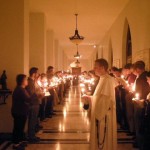I totally understand if you read the first take here and then don’t get around to reading takes 2-7 for an hour, or even until tomorrow, because I’ve got good news: Monument Valley has released new levels! In case you’re not familiar with the game, its tagline is “An illusory adventure of impossible architecture and forgiveness” and here’s the little trailer for the original game:
You play by exploring the MC Escher like landscapes and can often bridge an impossible gap by viewing your location from a different angle and taking advantage of an illusory connection. This is, hands down, my favorite game I’ve ever played on a phone or anywhere else. Everything was beautiful to look at, the story was interesting, the moves were fun to figure out. I even liked that there were only eight levels, so I could enjoy the game without being swallowed up by it.
Now, there are eight more, and I really recommend trying the original game (if you haven’t yet) and then plunking down $2 for the expansion.
Now, if you’re in the mood for more illusions, I recommend this Nautilus feature on Kokichi Sugihara, who builds clever 3D illusions, with a little help from a program he wrote:
Sugihara didn’t originally set out to become a master illusionist. As a young mathematician in 1980, he was interested in robot vision and computer-assisted design. With those applications in mind, he created a computer program that could take a line drawing of a polygonal shape and come up with a list of three-dimensional objects that would create that drawing when projected onto a flat plane—akin to working backward from a shadow to the possible objects that could have cast it. To test his program, Sugihara fed it drawings of impossible-seeming objects, like M.C. Escher’s endless loop of stairs. He expected the program to reject the drawings, but to his surprise, in some cases it claimed to have found a solution: a three-dimensional object that looked just like the drawing. “I thought my software was incorrect,” Sugihara said.
On closer inspection, he realized that what was incorrect was his assumption that these “impossible” two-dimensional objects couldn’t exist in the three-dimensional world. He started making paper models of his program’s designs, and gradually, the robot and design applications fell by the wayside—his program wasn’t ideally suited to them, he discovered. Instead, he dedicated himself to exploring the strange constructions that came so easily to his program, and that appeared so baffling to human viewers. He had built an illusion machine.
One of his illusions is below, and you can see more at Nautilus.
And also falling under the category of the art of illusion, I think, is this story about the techniques the French use to dub movies. I’m being very strict with myself in only using two pull-quotes; the entire piece is full of fascinating information:
This is how they do it: just seconds of footage at a time. Everyone in the room watches a few lines of English dialogue with a rolling French script at the bottom of it. The engineer presses stop. For movies, the actors have generally never seen the scene before, and sometimes, they can’t even see it now — Hollywood is terrified of films getting leaked on the internet, so when Dubbing Brothers received each Lord of the Rings movie, the studio had blacked out the entire screen except for little boxes around the actors’ mouths, and even those closed when the actors weren’t talking. So everyone watches — or doesn’t watch — the scene, maybe twice. The engineer presses rewind. And it’s time to record the voice-over.
…
Perret the Younger, who scripts big releases from The Hunger Games to The Hundred-Foot Journey, walks me through it in her home office. She explains how she goes through the English script and creates, for every sentence, a sentence that is nearly identical in meaning but also as similar as possible in length. This alone is a gargantuan task, with the way French languidly weaves its way around getting an idea across. But in addition, and to make the dub look as realistic as possible, she must also identify every instance of a character uttering a word with an m, p, or b in it in English, and find a word in French with the same consonant. And the replacement word has to fit into that sentence in exactly the same spot as where the American actor’s mouth makes the m, p, or b face. She must also figure out what to put in the place of people’s first names, which she tells me Americans incessantly address each other by in movies, and even more in TV shows, but which never happens and would sound utterly bizarre in French.
Now, for a slightly less wild palate cleanser, I really liked this NYT piece on a project to reinterpret Audubon’s portraits of birds and to paint them on NYC rolldown store fronts. Here’s Boy Kong’s take on the Tundra Swan:
Here’s another artfully constructed real thing (that still partook of the art of illusion and deception). It’s the story of a very strange bug the Soviets planted in our embassy:
Cracking it open, they found a hollow cavity and a metal object so unusual and mysterious in its design that it has gone down in history as ‘The Thing’.
‘The Thing’ had no battery, no wires, no source of power at all. It was was just a little can of metal covered on one side with foil, with a long metal whisker sticking out the side. It seemed too simple to be anything.
That night the American technician slept with ‘The Thing’ under his pillow. The next day they smuggled it out of the country for analysis.
The Americans couldn’t figure out how ‘The Thing’ worked, and had to ask the British for help. After a few weeks of fiddling, the Brits finally cracked The Thing’s secret.
Click here to read more (I was really pleased by the reveal).
Speaking of delight in the way things work, try out this quote from Robert Bringhurst’s Elements of Typographic Style:
Portions of this chapter are peppered with numbers. Some passages are also thick with the language of simple mathematics. Readers may well ask whether all this is necessary, merely in order to choose where some letters should sit on a piece of paper and where the paper itself should be trimmed. The answer, naturally, is no. It is not in the least necessary to understand the mathematics in order to perform the actions that the math describes. People walk and ride bicycles without mathematical analyses of these complex operations. The chambered nautilus and the snail construct perfect logarithmic spirals without any need of logarithmic tables, sliderules or the theory of infinite series. The typographer likewise can construct beautiful pages without knowing the meaning of symbols like π or φ, and indeed without ever learning to add and subtract, if he has a well-educated eye and knows which buttons to push on the calculator and keyboard.
The mathematics are not here to impose drudgery upon anyone. On the contrary, they are here entirely for pleasure. They are here for the pleasure of those who like to examine what they are doing, or what they might do or have done, perhaps in the hope of doing it still better.
(found via Alan Jacobs, whose biography of C.S. Lewis I’m currently reading)
Finally, a fantastic essay on things not working, in which Kate Havard talks about how much she got out of a profoundly flawed Henry V:
After the show, I went to find the stage manager. As it turned out, the lead actor had fallen seriously ill the night before, in the middle of the performance. But because it was still very early on in the run, the understudy hadn’t yet learned all of Henry’s lines (understudies typically don’t start full rehearsal until the show is underway). When the lead actor went down, the stage managers waved the understudy offstage (he had been playing one of the rowdy tavern dwellers), placed a crown on his head, and told him he would have to go on as King.
With this knowledge, the show went from an illustration of embarrassingly bad Shakespeare to a metaphor for Prince Hal’s life: a barfly in the background who, due to forces outside his control, needed to become a King—and fast. No wonder that on a stage full of nobles and princes, the understudy seemed so wrong. He was never supposed to be there in the first place.
I learned from the cast that the lead was so sick that the understudy would be going on again in the next performance. He had two days to become Henry V. So I went back to the second performance wondering: could he do it?
That night, the air of heroic inevitability that often surrounds King Henry was gone.
For more Quick Takes, visit Conversion Diary!














